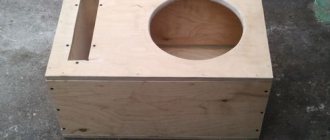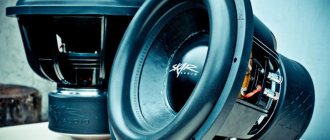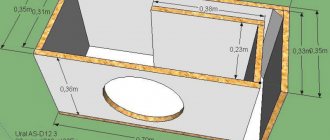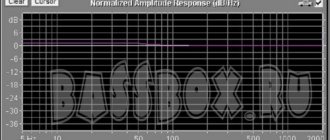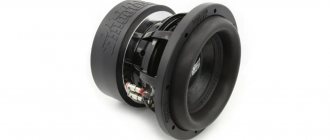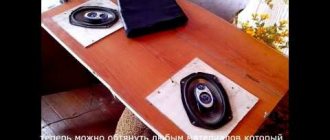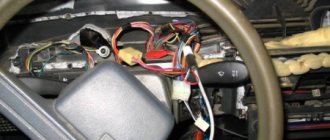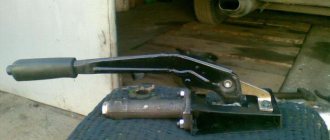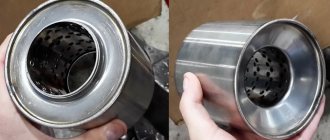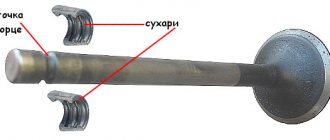In car audio, there are many options for acoustic design of boxes. Therefore, many beginners do not know what is the best choice. The most popular types of subwoofer boxes are a closed box and a bass reflex box.
There are also designs such as bandpass, quarter-wave resonator, freeair and others, but when building systems they are used extremely rarely for various reasons. The speaker owner must decide which subwoofer box to choose based on sound requirements and experience.
We advise you to pay attention to the article on what material is best to make a subwoofer box from. We have clearly demonstrated how the rigidity of the box affects the quality and volume of the bass.
How does a subwoofer box affect the sound?
In car audio, there are many options for acoustic design of boxes.
Therefore, many beginners do not know what is the best choice. The most popular types of subwoofer boxes are a closed box and a bass reflex box. There are also designs such as bandpass, quarter-wave resonator, freeair and others, but when building systems they are used extremely rarely for various reasons. The speaker owner must decide which subwoofer box to choose based on sound requirements and experience.
We advise you to pay attention to the article on what material is best to make a subwoofer box from. We have clearly demonstrated how the rigidity of the box affects the quality and volume of the bass.
Glass fabric
Fiberglass is used to make stealth subwoofers or to give non-standard shapes to parts of the housing. The mold is covered with fabric, impregnated with polyester resin. Using such material it is quite difficult to achieve the required thickness, so additional stiffening ribs must be used. In general, making such a case is a labor-intensive process, but the result is aesthetically worth it.
The question is often asked: “Does it make sense to remake a factory subwoofer enclosure?” If you remake the factory housing of a budget sub, there will be an improvement and it will be audible. But since the speaker is most likely bad, it will limit the degree of improvement.
For a high-quality subwoofer, choose the right material. Good luck with your builds!
Closed box
This type of design is the simplest. A closed box for a subwoofer is easy to calculate and assemble. Its design is a box of several walls, most often 6.
Advantages of ZY:
- Simple calculation;
- Easy assembly;
- Small displacement of the finished box, and therefore compact;
- Good impulsive characteristics;
- Fast and clear bass. Plays club tracks well.
A closed box has only one drawback, but sometimes it is decisive. This type of design has a very low level of efficiency compared to other boxes. A closed box is not suitable for those who want high sound pressure.
However, it is suitable for fans of rock, club music, jazz and the like. If a person wants bass, but needs space in the trunk, then a closed box is an ideal option. A closed box will not play well if the wrong volume is selected. What volume of box is needed for this type of design was long ago decided by experienced people in car audio through calculations and experiments. The choice of volume will depend on the size of the subwoofer speaker.
The most common speaker sizes are: 6, 8, 10, 12, 15, 18 inches. But you can also find speakers of other sizes; as a rule, they are used very rarely in installations. Subwoofers with a diameter of 6 inches are produced by several companies and are also rarely found in installations. Mostly people choose speakers with a diameter of 8-18 inches. Some people indicate the diameter of the subwoofer speaker in centimeters, which is not entirely correct. In professional car audio, it is customary to express dimensions in inches.
Recommended volume for a closed box subwoofer:
- an 8-inch subwoofer (20 cm) requires 8-12 liters of net volume,
- for 10-inch (25 cm) 13-23 liters of net volume,
- for 12-inch (30 cm) 24-37 liters of net volume,
- for 15-inch (38 cm) 38-57 liters net volume
- and for 18 inches (46 cm) you will need 58-80 liters.
The volume is given approximately, since for each speaker you need to select a certain volume based on its characteristics. The setting of a closed box will depend on its volume. The larger the volume of the box, the lower the tuning frequency of the box will be, the bass will be softer. The smaller the volume of the box, the higher the frequency of the box, and the bass will be clearer and faster. You should not increase or decrease the volume too much, as this is fraught with consequences. When calculating the box, adhere to the volume that was indicated above. If there is too much volume, the bass will turn out vague and indistinct. If the volume is not enough, then the bass will be very fast and “pound” the ears in the worst sense of the word.
A lot depends on how the box is configured, but an equally important point is “Setting up the radio.”
Subwoofer housing: how to make it yourself
Taking into account the fact that the bandpass is the most difficult to manufacture, this enclosure is difficult to design and calculate the subwoofer box without special skills, knowledge and experience.
On the one hand, you can use the WinlSD program to calculate the subwoofer. This software allows you to select the size, calculate the volume of the subwoofer, and even create a three-dimensional model.
However, on the other hand, such a task is usually beyond the capabilities of an ordinary car owner without special knowledge (you need to know the characteristics of the speaker, take into account a number of additional features, etc.).
In fact, to make a sub with your own hands, it is better to choose a closed box or bass reflex. In this case, it is recommended to pay attention to the second option as a homemade subwoofer.
This solution (subject to proper design) will be more than enough. The bass reflex makes it possible to play back the lowest frequencies with high quality, provides increased efficiency, etc.
So, first we select the material for making the subwoofer. Typically, multilayer plywood is used for these purposes. You can also take chipboard. These materials are affordable, easy to work with, and provide good sound insulation.
- As an example, consider a subwoofer made of multilayer plywood (3 cm thick). In order to make a box for a subwoofer, you need to prepare, on average, about 100 wood screws 50-55 mm.
You also need to purchase sound insulation, have a drill, a screwdriver or screwdriver, a jigsaw, liquid nails, sealant and PVA glue, about 3 meters of carpet and a terminal block. The next step is the drawings of the subwoofer box.
The calculation of the subwoofer box is individual; the parameters depend on the size of the speaker, etc. Using an example, consider a sub with one 12-inch speaker. The volume of a box for a subwoofer with one such speaker, according to the recommendations of experts, is 45-50 liters.
To calculate the box for the subwoofer, below is an introductory diagram with the dimensions of the panels. If you do not have the skills to do this kind of work, it is recommended that you separately study the materials on how to make a drawing for a subwoofer yourself.
During design, you need to separately ensure that the minimum distance from the walls of the case to the speaker, as well as the volume of the box itself, is calculated exclusively on the inner surface, and not on the outer one.
Let's move on. After preparing all the elements, you can proceed to assembling the subwoofer box. First of all, use a jigsaw to cut out a hole for the speaker. For example, a speaker is 30 cm. Please note that the shortest distance from the center of the diffuser to the wall of the subwoofer is, conditionally, 200 mm. You can measure 230 mm, since 3 cm is the width of the plywood itself.
Then a hole is cut for the bass reflex slot. You can also use a tube instead of a slit. Then you can assemble the bass reflex slot, and then attach it to the front panel of the subwoofer. The joints are glued with liquid nails, then screws are tightened. The screws must be tightened as tightly as possible to avoid resonant vibrations.
Now you can assemble the side walls of the case, coating them in the same way with liquid nails and tightening them with self-tapping screws. You also need to cut a hole for the terminal block on the back cover of the case for the subwoofer. Next, all parts of the subwoofer need to be connected, checking the correct dimensions of the structural elements themselves and the quality of fastening.
At this stage, you can insert the speaker without screwing it in, check its fit and then move on to finishing the box. At the initial stage, it is necessary to glue the joints, cracks and gaps with epoxy glue. You can also use sealants. Then, using PVA glue, the entire upper surface is glued with sound insulation.
The outer surface is covered with carpet (including the bass reflex slot). The carpet is attached with epoxy glue and/or a furniture stapler. The speaker can now be reinserted and screwed in place. The final stage is drawing the wires from the speaker to the terminal block. After the entire structure has “settled” and dried, the sub can be connected to the amplifier. To do this, you need to know how to connect a subwoofer in a car correctly.
Bass reflex
This type of design is quite more difficult to calculate and build. Its design is significantly different from a closed box. However, it has advantages, namely:
- High level of efficiency. A bass reflex will produce low frequencies much louder than a closed box;
- Simple calculation of the body;
- Reconfiguration if necessary. This is especially important for beginners;
- Good speaker cooling.
The bass reflex also has disadvantages, the number of which is greater than that of the ZYa. So, the cons:
- FI is louder than ZY, but the bass here is not so clear and fast;
- The dimensions of the FI box are much larger compared to the ZY;
- Large displacement. Because of this, the finished box will take up more space in the trunk.
Based on the advantages and disadvantages, you can understand where FI boxes are used. Most often they are used in installations where loud and pronounced bass is needed. The bass reflex is suitable for listeners of any rap, electronic and club music. It is also suitable for those who do not need free space in the trunk, since the box will occupy almost all the space.
The FI box will help you get more bass than from a small-diameter speaker. However, this will require much more space.
What volume of box is required for a bass reflex?
- for a subwoofer with a diameter of 8 inches (20 cm) you will need 20-33 liters of net volume;
- for a 10-inch speaker (25 cm) – 34-46 liters,
- for 12-inch (30 cm) – 47-78 liters,
- for 15-inch (38 cm) – 79-120 liters
- and for an 18-inch subwoofer (46 cm) you need 120-170 liters.
As with ZY, the numbers given here are imprecise. However, in a FI case you can “play” with the volume and take a value less than recommended, finding out at what volume the subwoofer plays better. But do not increase or decrease the volume too much, this can lead to loss of power and failure of the speaker. It is best to rely on the recommendations of the subwoofer manufacturer.
What does the FI box setting depend on?
The larger the volume of the box, the lower the tuning frequency, the bass speed decreases. If a higher frequency is needed, then the volume must be reduced. If your amplifier's rated power exceeds the speaker's rating, then it is recommended to make the volume smaller. This is necessary in order to distribute the load on the speaker and prevent it from exceeding the stroke. If the amplifier is weaker than the speaker, then we recommend making the volume of the box a little larger. This compensates for the volume due to the lack of power.
Case size calculation
When the volume of the body is known, the shape of this body does not affect the sound. There are various programs for calculating a box for a subwoofer (a program for calculating a subwoofer box is “JBL SpeakerShop” or “Winisd beta.”), but you can simply do the calculation, knowing yourself that the volume is V=hx L x A (where h is the height , L - length, A - width).
For example, how to calculate a box for a subwoofer, if for a 12-inch subwoofer (305 mm), the recommended volume is 45 liters. The measured permissible height for the body in a car is 340 mm (h=340 mm), length 680 mm (L=680 mm), let's calculate the width. A=V/Lxh
Bass reflex tuning frequency
Introduction
When calculating the port, you need to choose your preferred music genre. If you are rock fans, then a low port setting will not suit you, and vice versa, when listening to blacks, a high port setting will not suit you.
For beginners, it is better to choose something universal and preferably on a pipe, since the slot box cannot be simply remade to change the setting.
Music genres:
- Low setting
- frequency 25 - 29 Hz. For fans of flex, the car shakes, the windshield blows up and the most important thing is the wind, a lot of wind. The bass with this setting is deep and soft, which does not hurt the ears. — With this setting, the subwoofer will not play strawberry, electro, rock and pop music. — Not all subwoofers are capable of reproducing such frequencies normally. - Everyday setting
is frequency 30 - 35 Hz. The most common and popular port setting. For fans of blacks and dub step, where there is body flex. The bass with this setting is more pressing to the ear. - Musical setting
- frequency 36 - 40 (42) Hz.
Universal setting or, more correctly, BALANCE
between all genres. The bass with this setting is more pronounced, fast but hard. Flex, accordingly, is minimal. — Short-throw subwoofers are more suitable. — Option aside sound quality. - Sport setting
- frequency above 45 - 55 Hz.
This setting is used for sound pressure measurements at competitions. People call such a box a COMBAT box
. The bass with this setting is very hard and it is impossible to listen to music. — We do not recommend using this setting for everyday listening.
How to determine the bass reflex tuning frequency?
- The easiest way to check the bass reflex tuning frequency is using the Frequency Tone Generator. At the box tuning frequency, the speaker cone stroke is minimal. We start the tone generator, set the approximate frequency and, in 1 Hz steps, determine at what frequency the stroke is minimal.
- The second method is no less simple, similar to the first. It is necessary to place the subwoofer with the diffuser up and pour cereal or something small and light onto it. We start the tone generator, set the approximate frequency and, in 1 Hz steps, determine at what frequency the material remained motionless, and at frequencies higher or lower it jumped noticeably. This frequency will be the bass reflex tuning frequency.
Recommendations
We advise you to choose the acoustic design of the box, specifically on the pipe, if you need precise tuning, or to get the desired result from measurements.
If you don’t like the port setting, you can simply change it to a longer one or cut off the pipe.
- The shorter the pipe, the higher the setting;
- The longer the pipe, the lower the setting.
Don’t forget, there is no exact port tuning frequency by calculation; plus or minus 2 Hz deviation is the norm.
Reworking the FI box settings for subwoofers - Community "Autozvuk" on DRIVE2
Good afternoon, friends, cool guys can immediately close this post, it will most likely be of interest only to beginners, we will talk about choosing the bass reflex box settings for preferences in music and its effect on sound pressure, using the example of a specific car. The box was made not so long ago setting the 28Hz port for wind, flex, low bass. With this setting, the following genres of music will sound great: blacks and dubstep. The bass will be soft, velvety, creating maximum air movement throughout the car interior; there will be increased vibrations of the interior and body elements.
Now I decided to remake the box with a higher setting, for this I slightly tightened the volume from 65 dirty liters per dyne to 50 and shortened the phasic setting to about 35 hertz. Considering the resonant frequency of my cabin is around 42 hertz, I expect to get one more or less even rise, it was like this. With this setting, club music, pop, rock, in general, music where there is a drum instrument and not a subwoofer should sound great. The bass turned out to be more collected, detailed, so to speak.
Considering the resonant frequency of my cabin is around 42 hertz, I expect to get one more or less even rise, it was like this. With this setting, club music, pop, rock, in general, music where there is a drum instrument and not a subwoofer should sound great. The bass turned out to be more collected, detailed, so to speak.
As for the effect of tuning on the result, the closer to the resonant frequency of the cabin, the higher the sound pressure. In my car, the goal of obtaining the maximum result will not be listened to because this is just a number, listening to a box tuned to the resonant frequency of the interior every day is a perversion, the hump will be very pronounced, the drum in all compositions will be approximately the same by ear. Despite this, the result naturally increased: 140.9, amplifier the same cadence dakota in the 1st speaker DD 512 two pieces.
ps. I don’t claim to be the ultimate truth for the guru, these are my conclusions on this matter, I’m fine with gentle additions in the comments 
Which box setting to choose
Hi all. Please tell me, my friend and I decided to make a FI box for 12 din and chose the 35 hertz setting. We thought it would play softly and low, but it turned out that there was more pressure than bass. We tried to put both Kix and Mystery there. They play the same way, there is not enough softness and elasticity of the bass.
Search data for your request:
Wait for the search to complete in all databases. Upon completion, a link will appear to access the found materials.
Go to search results >>>
WATCH THE VIDEO ON THE TOPIC: How to make a box for a subwoofer + BONUS: KILLING a URAL subwoofer
How to make a stealth subwoofer with your own hands
Having considered how to make a box with your own hands, it should be noted that the owner does not always intend to install a large box in the trunk. For this reason, many car enthusiasts are interested in how to make a stealth subwoofer with their own hands.
It is well known that a stealth subwoofer is practical, does not take up much space and is often a factory solution on cars where a subwoofer is used in the speaker system.
As a rule, such a stealth sub is installed in the inner part of the wing. If you install it yourself, you can use the niche for the spare wheel. The minimum box volume for a 10" to 12" speaker is 18L.
Let us immediately note that making and installing a stealth subwoofer with high quality is more difficult and more expensive than a regular box. If only this option is needed, then for manufacturing and installation you will need:
- woofer;
- grill grate for protection;
- socket for connecting to an amplifier;
- wire for connecting the woofer to the outlet;
- Chipboard or multilayer plywood (thickness 2 cm);
- some fiberboard, epoxy glue, fiberglass;
- wood screws, mounting tape and plastic film;
- tools you need are a screwdriver, a drill, a jigsaw and a brush;
Having decided on the installation location, you need to unload the trunk, remove the trunk trim at the subwoofer installation site in order to be able to install the subwoofer as close as possible to the car fender.
At the initial stage, you need to lay a plastic film on the floor in the trunk to protect the inner lining from epoxy glue and to implement a fastening for screwing the back wall of the sub. Then you will need to cover the inside with tape. The adhesive tape is glued in a couple of layers.
Now you need to cut the fiberglass into small pieces (pieces 20 cm in length and width). Next, these pieces are applied to masking tape, after which they are glued with epoxy glue. It is better to lay fiberglass overlapping, which allows you to get rid of noticeable seams, joints, etc.
Next, the layers of fiberglass are glued to each other, coating each layer with epoxy glue. The main task is to obtain a sheet about 1 cm thick, which will require 4 or 5 layers.
Then you need to let the material harden for about 12 hours. If you don’t want to wait, you can speed up the drying process using a lamp. After the material has dried, you need to cut out the bottom of the subwoofer and glue it to the body. The joint can be glued with epoxy resin or it will need to be treated with a sealant.
The main task, the shape should be made so as not to interfere with the trunk hinges, that is, the homemade subwoofer should not interfere with the trunk closing. Having removed all the unnecessary parts, all that remains is to cut out the side walls from the chipboard, as well as the top part - the lid. The rounded part can be made from plywood, and no special calculations are required.
We also recommend reading the article on how to connect a subwoofer in a car. From this article you will learn about ways to connect a subwoofer in a car, how to connect a subwoofer without an amplifier, features of connecting a subwoofer to a radio, etc.
The only thing to get a rounded shape is to wet the plywood, bend it as needed, then attach it and wait until it dries completely. All chipboard sheets must be glued with epoxy glue or sealants used, and then tightened with self-tapping screws. As for the fiberglass box, it is also glued with epoxy resin, and after the resin dries, self-tapping screws are used for fastening.
To achieve a good seal, the seams are taped again. After applying epoxy glue, it is better to “load” the structure by placing something heavy and thereby pressing all the joints against each other. This way the glue adheres better and the joints are stronger.
Now all that remains is to take measurements of the front panel, after which it can be cut. Then a hole for the speaker is cut out with a jigsaw. After the panel is ready, it is attached to the body with self-tapping screws.
To do this, bars are placed along the entire inside of the panel (the distance is maintained slightly greater than the thickness of the plywood). For example, 2.5 cm from the edge. This solution will allow you to mount the front part at the top, bottom, left and right. The result is a reliable connection, especially with the round part.
The final step is cutting out a hole for the socket, which is done in the end part. Upon completion, the strength of the structure is assessed. If necessary, you can add more layers of epoxy and fiberglass to the curved part.
If the end result is satisfactory, then you can install the socket, connect the speaker to it, but do not screw it in. As a finishing touch, you can cover the sub with carpet or paint it. The painting option is more complex and time-consuming, but the end result is more aesthetically pleasing. To paint, you must first level the surface.
This can be done using universal putty. After drying, all that remains is to level the surface with medium and then fine sandpaper, then prime and paint the body.
How to choose the HF box setting for a subwoofer
The recommended net volume of a closed box, based on one 8-inch speaker, is from 8 to 12 liters.
The recommended net volume of a closed box, based on one 10-inch speaker, is from 13 to 23 liters. The recommended net volume of a closed box, based on one 12-inch speaker, is from 24 to 37 liters. The recommended net volume of a closed box, based on one 15-inch speaker, is from 38 to 57 liters. The recommended net volume of a closed box, based on one 18-inch speaker, is from 58 to 80 liters.
The recommended net volume of the bass reflex box, based on one 8-inch speaker, is from 20 to 33 liters. The recommended net volume of the bass reflex box, based on one 10-inch speaker, is from 34 to 46 liters. The recommended net volume of the bass reflex box, based on one 12-inch speaker, is from 47 to 78 liters. The recommended net volume of the bass reflex box, based on one 15-inch speaker, is from 70 to liters. The recommended net volume of the bass reflex box, based on one 18-inch speaker, is from up to liters.
You can also use our box volume calculator. The internal “dirty” volume of the box, which includes the clean volume of the box and the volume displaced by the speaker. The internal “dirty” volume of the box, which includes the clean volume of the box, the volume displaced by the speaker and the port. The volume displaced by the speaker elements located inside the box.
12" subwoofer box
The recommended net volume of a closed box, based on one 8-inch speaker, is from 8 to 12 liters. The recommended net volume of a closed box, based on one 10-inch speaker, is from 13 to 23 liters. The recommended net volume of a closed box, based on one 12-inch speaker, is from 24 to 37 liters. The recommended net volume of a closed box, based on one 15-inch speaker, is from 38 to 57 liters. The recommended net volume of a closed box, based on one 18-inch speaker, is from 58 to 80 liters. The recommended net volume of the bass reflex box, based on one 8-inch speaker, is from 20 to 33 liters. The recommended net volume of the bass reflex box, based on one 10-inch speaker, is from 34 to 46 liters.
How to choose the HF box setting for a subwoofer
By Jendoss, November 19, in Subwoofers. Your BMW has a very low interior resonance, so you can safely tune it to Hz; there will be a lot of wind. That's how you do it. There's nothing to invent. Not only the settings, but also how people do the volume, what is the area of the port. This is how I understand this every day, and you recommend a 40 hertz setting. Nobody needs a buzzer, in my opinion it’s much more pleasant to feel a lot of wind in the cabin than a headache! Jendoss, Try it, cut a couple of cm, listen. Where you like it most, leave it at this length.
Phase reflex tuning frequency
You've probably at least heard something about quarter-wave resonators. This type of enclosure is not so widely used in the construction of subwoofers and low-frequency sections of acoustic systems compared to, say, a bass reflex and a closed box. But why? After all, a quarter-wave oven provides undoubted fat advantages: Perhaps the widespread use of CV is also limited by the somewhat laborious nature of its calculations. Although the calculation itself is not that complicated, usually while you are designing a box, you have to go through several options, recalculating everything again each time.
Material for making a box for a subwoofer
Material for making a box for a subwoofer
The most suitable material is multi-layer plywood. But out of the wide variety of plywood varieties that exist, not all of them are suitable for making a subwoofer enclosure. So, when using ordinary plywood with insufficient density for these purposes, sound distortion is guaranteed. Another situation is when we are dealing with multi-layer (12 layers) plywood, in the manufacture of which ship wood or Russian birch is used. It is an excellent material for making small sound systems. Such plywood has sufficient density, at the same time, in comparison with such dense materials as particle board (chipboard) and fibreboard (MDF), it is much lighter. Multilayer plywood is easy to process; when screwing in screws, there is no fear that it will delaminate. In a word, plywood is a good subwoofer material for a small volume.
Subwoofer material
–
Plywood or chipboard
It turns out that a plywood sheet with a thickness of 12 mm has better resonance characteristics than boards with a thickness of 16 mm of different types of wood. But it is necessary to take note that large cases made from this plywood ring.
It is simply not acceptable in the manufacture of buildings with large flat spans.
Particle boards. These products are among the most common materials today. In stores and on the market you can find different types of DS boards, but when making cabinets it is recommended to use chipboards
that have the highest density.
True, such slabs are heavier than others, but they are easier to process and sound better. Chipboard with a thickness of 16 mm is perhaps the best material when making powerful low-frequency speaker systems, due to its high density and weak resonant qualities.
Chipboard is one of the inexpensive, readily available materials. True, this material has a significant drawback: it is afraid of moisture, easily absorbs it and swells. Therefore, the chipboard body should be painted immediately after manufacturing. Also, chipboard is very difficult to process with circular or band saws.
— Plywood is a good material, but it is expensive, and with large volumes it makes noise, you need to install stiffening ribs. — Chipboard is cheaper and has greater rigidity.
Source
Secrets of the musical bass. A guide to setting up a subwoofer for beginners. Subwoofers.
In car audio, there are many options for acoustic design of boxes. Therefore, many beginners do not know what is the best choice. The most popular types of subwoofer boxes are a closed box and a bass reflex box. There are also designs such as bandpass, quarter-wave resonator, freeair and others, but when building systems they are used extremely rarely for various reasons. We advise you to pay attention to the article on what material is best to make a subwoofer box from. We have clearly demonstrated how the rigidity of the box affects the quality and volume of the bass. This type of design is the simplest.
Third step: adjust output sensitivity
The output sensitivity adjustment filter also looks like a wheel for scrolling with a screwdriver and is designated “GAIN” or “LEVEL”.
There is a misconception that this parameter is responsible for the volume of the subwoofer, in fact this is not the case, even though when set to the upper positions the volume does increase. This filter is responsible for the coordinated operation of the head unit and subwoofer, and is configured using a specific method that has four simple steps:
- set the controls on the radio and amplifier to minimum and the sound signal will sound to check;
- the volume gradually increases until the first distortions in the sound appear, after which it returns to the last position at which there was a clear sound;
- then the regulator on the amplifier rotates upward until the first sound distortions appear;
- as soon as distortions appear, the regulator returns to the extreme position at which they did not exist.
Subwoofer installation
I’ll disappoint you right away, there is no correct design for a subwoofer and there never will be, because it’s different for everyone. Which one is right for you depends on your musical preferences and the space you can sacrifice in the trunk. The most compact of all designs and the easiest to manufacture is ZYA. But it has the lowest efficiency. The sound of this performance is soft and not particularly loud.
What frequency should you set the bass reflex to? The frequency of the phasic port can be selected based on your preferences in music. With this setting, the ears do not suffer - it is a soft bass! Usually they think that if the hair blows out, it means there is pressure on the ears and how it sits there. With such a setup, you can forget about strawberry, electro, especially pop music.
Switch to English registration. Phone or email. Another's computer. Flea market of AutoSound Ukraine.
Choosing a box for a subwoofer. Types of boxes
Here we will look at the three main types of boxes (boxes) used in subwoofers (as well as in other speakers). But first, a little about the purpose and function of any box. The acoustic head emits sound not only “forward” but also backward, while the front and rear sound waves are opposite in phase. In this regard, there is a term “acoustic closure”, in which the waves on both sides of the diffuser add up and (if they are opposite in phase) cancel each other out. In this case, ideally you will not hear anything at all, but in practice the sound will be very far from the original. The acoustic system box allows you to eliminate this short circuit and give the sound the required characteristics in terms of power and frequency.
Which material is better
What is the best way to make a subwoofer box?
In principle, there are many materials from which a housing for such a speaker can be made. It can be plywood, MDF, chipboard and so on. Each of these materials has not only advantages, but also disadvantages.
Note. The best material for making a subwoofer enclosure, according to many experts, is shipboard laminated plywood.
Finding ship plywood is not as difficult as it seems at first glance. Construction sites and other manufacturing enterprises have such material. Formwork is often made from this plywood. This material is always moisture resistant, very durable and tough. In a word, for a subwoofer body this is what you need.
Note. It will be useful to know that in the West, where the manufacture of homemade enclosures for subwoofers is highly encouraged, they prefer MDF. They don’t have any marine plywood at all, and many experts see this as the reason for their love for MDF.
Chipboard is also a good material, but it doesn’t like moisture at all. In addition, when processed, chipboard tends to crumble. On the other hand, if you take thicker material, the problem can be solved.
What to make a subwoofer box from
Some experts also recommend other materials, but they are, as a rule, not so popular - for example, glued laminated boards.
What is the best material to make a subwoofer box from?
Closed box (ZY) - sealed box
This is the easiest type of acoustic design for speakers to manufacture. The vibrations in such a box are in a closed volume and are eventually damped. But since a sound wave is energy, when it decays it turns into heat. And although the amount of this heat is small, it still affects the characteristics of the acoustic system. (warmer air expands and increases the rigidity of the system). To prevent this effect, the core is filled from the inside with sound-absorbing material, which, while absorbing sound, also absorbs heat. The increase in air temperature becomes much smaller and it “seems” to the dynamics that there is a significantly larger volume behind it than in reality. In practice, in this way it is possible to increase the “acoustic” volume of the box compared to the geometric one by 15-20%.
Plywood
Plywood (laminated wood board) is a multilayer material that is made by gluing prepared veneer. To increase strength, layers are applied so that the wood fibers are strictly perpendicular to the previous sheet.
The most popular material for making your own subwoofer. It happens: construction, industrial, packaging, furniture and structural. It’s better to use furniture; if you’re lucky enough to find a structural one, it’s generally great.
Plywood has high strength, is easy to process, and with sufficient thickness gives good rigidity to the body, but can delaminate during assembly.
Medium Density Fiberboard (MDF) - made by dry pressing small wood chips at high pressure and temperature. It is very well suited as a material for subwoofer housings and acoustic speakers in general, as it has a homogeneous structure, absorbs sound well and is easy to process. It has a high density and holds screws well. An MDF box of sufficient thickness is dull, durable, and has no resonances.
Bass reflex (FI) - vented box
A bass reflex is the next most common type of acoustic design. In a bass reflex, part of the energy that is “put against the wall” in a closed box is used for peaceful purposes. To do this, the internal volume of the box communicates with the surrounding space through a tunnel containing a certain mass of air. The size of this mass is chosen in such a way that, in combination with the elasticity of the air inside the box, it creates a second oscillatory system that receives energy from the back side of the diffuser and radiates it where needed and in phase with the radiation of the diffuser. This effect is achieved in a not very wide frequency range, from one to two octaves, but the efficiency is within its limits. increases significantly.
In addition to higher efficiency The bass reflex has another important advantage - near the tuning frequency, the amplitude of the diffuser oscillations significantly decreases. This may at first glance seem like a paradox - how the presence of a hefty hole in the loudspeaker housing can restrain the movement of the cone, but nevertheless. In its operating range, the bass reflex creates completely greenhouse conditions for the speaker, and exactly at the tuning frequency the oscillation amplitude is minimal, and most of the sound is emitted by the tunnel. The permissible input power is maximum here, and the distortion introduced by the speaker is minimal.
Above the tuning frequency, the tunnel becomes less and less “transparent” to sound vibrations, due to the inertia of the air mass contained inside it, and the loudspeaker acts as if it were closed. Below the tuning frequency, the opposite happens: the inertia of the speaker gradually disappears and at the lowest frequencies the speaker operates practically without load, that is, as if it had been removed from the housing. The amplitude of oscillations quickly increases, and with it the risk of spitting out the diffuser or damaging the voice coil from hitting the magnetic system. In general, if you do not take precautions, going for a new speaker becomes a real prospect.
A means of protecting against such troubles, in addition to being careful in choosing the volume level, is the use of infra-low-pass filters. By cutting off part of the specAvtozvuk Kirovtra, where there is still no useful signal (below 25 - 30 Hz), such filters prevent the diffuser from going into disarray at the risk of your own life and your wallet.
The bass reflex is much more capricious in the selection of parameters and settings, since three parameters are subject to selection for a specific speaker: box volume, cross-section and tunnel length. The tunnel is very often made so that with a ready-made subwoofer it is possible to adjust the length of the tunnel by changing the tuning frequency.
Bandpass loudspeaker - Bandpass
The third type of subwoofer, quite often used in car installations (although less frequently than the previous two) is a bandpass speaker. If a closed box and a bass reflex are high-pass acoustic filters, then a band-pass filter, as the name implies, combines high- and low-pass filters. The simplest bandpass loudspeaker is a single 4th order (single vented). It consists of a closed volume, the so-called. rear chamber and a second one, equipped with a tunnel, like a conventional bass reflex (front chamber). The speaker is installed in the partition between the chambers so that both sides of the diffuser operate in completely or partially closed volumes - hence the term “symmetrical load”.
Of the traditional designs, the bandpass loudspeaker, in any version, is the champion in efficiency. Moreover, efficiency is directly related to bandwidth. The frequency response of a bandpass loudspeaker has the shape of a bell. By selecting the appropriate volumes and frequency tuning of the front chamber, it is possible to build a subwoofer with a wide bandwidth, but limited output, that is, the bell will be low and wide, or it can be with a narrow bandwidth and very high efficiency. in this strip. At the same time, the bell will stretch in height.
The bandpass is a tricky thing to calculate and the most labor-intensive to manufacture. Since the speaker is buried inside the case, it is necessary to go to some lengths to assemble the box so that the presence of a removable panel does not violate the rigidity and tightness of the structure. The impulse characteristics are also not the best, especially with a wide bandwidth.
How is this compensated? First of all, as stated - the highest efficiency. Secondly, the fact that all sound is emitted through the tunnel, and the speaker is completely closed. When assembling such a subwoofer, considerable opportunities open up for installing it in a car. It is enough to find a small place at the junction of the trunk and the passenger compartment where the mouth of the tunnel can be placed - and the path is open to the most powerful bass. Especially for such installations, JLAudio, for example, produces flexible plastic tunnel sleeves with which it offers to connect the subwoofer output to the cabin. Like a vacuum cleaner hose, only thicker and stiffer.
Which box you choose for your speaker is of course up to you. And our auto studio will make this box for you.
